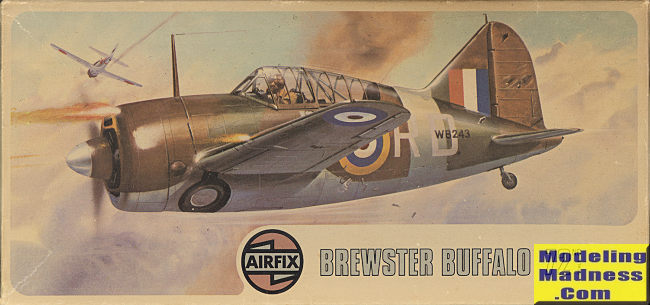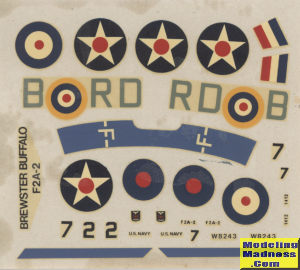
Airfix 1/72 Brester Buffalo
| KIT #: | 02050 |
| PRICE: | $3.00 'started' |
| DECALS: | Two options |
| REVIEWER: | Scott Van Aken |
| NOTES: | 1974 boxing |

| HISTORY |
The Brewster F2A Buffalo was an American fighter aircraft which saw service early in World War II. Designed and built by the Brewster Aeronautical Corporation, it was one of the first U.S. monoplanes with an arrestor hook and other modifications for aircraft carriers. The Buffalo won a competition against the Grumman F4F Wildcat in 1939 to become the U.S. Navy's first monoplane fighter aircraft. Although superior to the Grumman F3F biplane it replaced and the early F4Fs, the Buffalo was largely obsolete when the United States entered the war, being unstable and overweight, especially when compared to the Japanese Mitsubishi A6M Zero.
Several nations, including Finland, Belgium, Britain and the Netherlands, ordered the Buffalo. The Finns were the most successful with their Buffalos, flying them in combat against early Soviet fighters with excellent results. During the Continuation War of 1941–1944, the B-239s (a de-navalized F2A-1) operated by the Finnish Air Force proved capable of engaging and destroying most types of Soviet fighter aircraft operating against Finland at that time and achieving in the first phase of that conflict 32 Soviet aircraft shot down for every B-239 lost, and producing 36 Buffalo "aces".
In December 1941, Buffalos operated by both British Commonwealth (B-339E) and Dutch (B-339D) air forces in South East Asia suffered severe losses in combat against the Japanese Navy's Mitsubishi A6M Zero and the Japanese Army's Nakajima Ki-43 "Oscar". The British attempted to lighten their Buffalos by removing ammunition and fuel and installing lighter guns to improve performance, but it made little difference. After the first few engagements, the Dutch halved the fuel and ammunition load in the wing, which allowed their Buffalos (and their Hurricanes) to stay with the Oscars in turns.
| THE KIT |
 The
instruction sheet looks like it has been entombed for a few hundred years as
the paper is quite brown and somewhat stiff. Generic color information is
provided along with the Humbrol paint numbers of the early 1970s. Humbrol
has changed many of the numbers over the years, some of them several times.
The two options are for a VF-2 USN plane and a British one, which I guess
was based in Malaya or Burma as no unit information is provided. The decals
by this time are, as you can see, toast but there are others available if
you do a bit of looking. You could probably use a spare set from one of the
Hasegawa boxings.
The
instruction sheet looks like it has been entombed for a few hundred years as
the paper is quite brown and somewhat stiff. Generic color information is
provided along with the Humbrol paint numbers of the early 1970s. Humbrol
has changed many of the numbers over the years, some of them several times.
The two options are for a VF-2 USN plane and a British one, which I guess
was based in Malaya or Burma as no unit information is provided. The decals
by this time are, as you can see, toast but there are others available if
you do a bit of looking. You could probably use a spare set from one of the
Hasegawa boxings. | CONCLUSIONS |
This kit has been superseded over the years by that of Hasegawa which was released in the 1990s. However, if you don't mind the raised panel lines, rivets, and lack of inside detail, it still can be made into a very nice model for the shelves and can be found at a pretty low price.
| REFERENCES |
https://en.wikipedia.org/wiki/Brewster_F2A_Buffalo
March 2018 Copyright ModelingMadness.com. All rights reserved
If you would like your product reviewed fairly and fairly quickly, please contact the editor or see other details in the Note to Contributors.
Back to the Main Page Back to the Review Index Page Back to the Previews Index Page